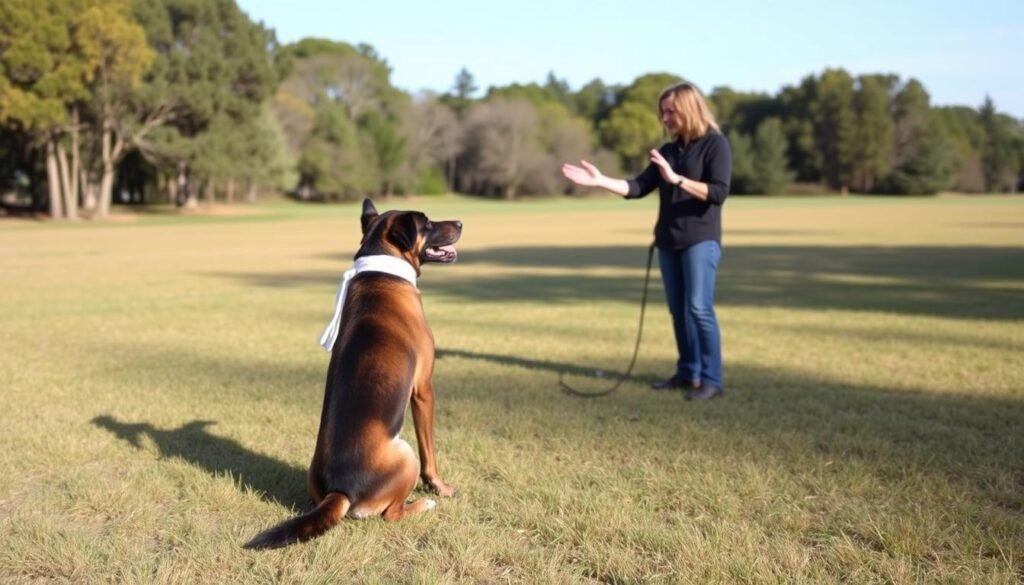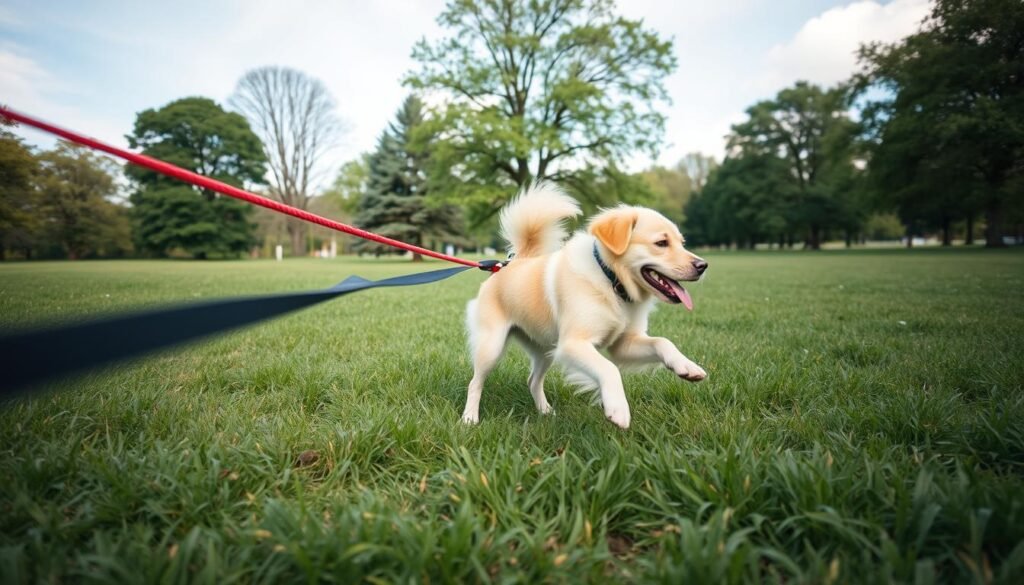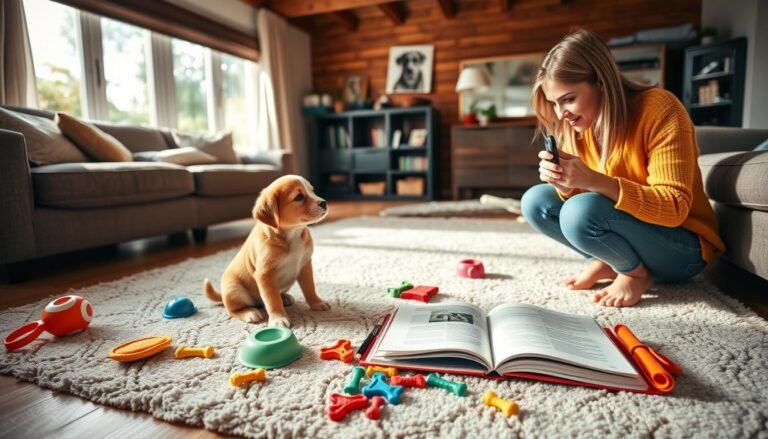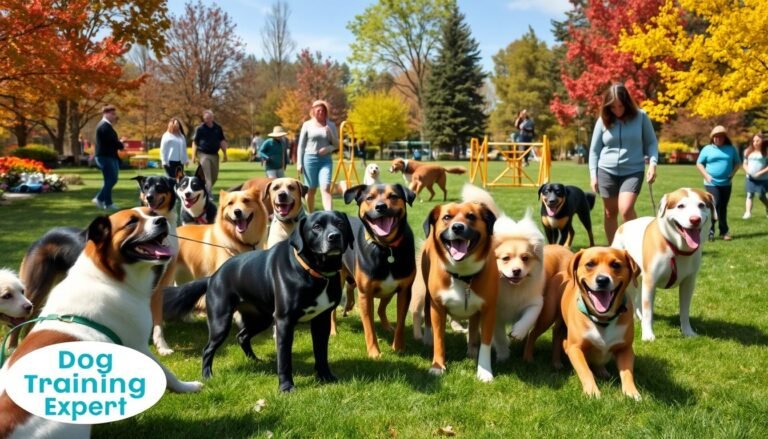Imagine walking in the park, with your dog happily exploring around you. Yet, they come back when you call them. Off leash training makes this possible. It strengthens your bond and brings freedom to your walks.
The thought of your dog freely exploring can be scary. But, proper training can ease your worries. It turns your walks into fun, trust-filled adventures.
This guide will help you master off leash training. It’s great for your dog, offering more exercise and fun1. No matter the breed, your dog can enjoy safe, happy walks off the leash2.
Key Takeaways
- Off leash training boosts your dog’s freedom, safety, and obedience1.
- Positive reinforcement is key to successful off leash training1.
- Retrievers, Spaniels, and Australian Shepherds are great for this training2.
- Checking if your dog is ready and can control their impulses is vital1.
- Training needs consistent practice and a good understanding of dog behavior2.

What is Off Leash Training?
Off leash training lets your dog walk freely while listening to your commands. It takes time and patience to master. Yet, this training gives your dog the chance to safely explore, boosting their physical and mental health.
Benefits of Off Leash Training
Off leash training greatly enhances your dog’s health. It allows for more physical activity and mental challenge without a leash. This practice deepens your bond with your dog through constant communication and trust. It also teaches them to act well in many situations, helping them stay safe and behave in public.
Common Misconceptions
Some think all dogs can easily adjust to off leash training without help. This isn’t true. Training off leash takes weeks, or even months, to get reliable responses3. There’s also a myth that dogs naturally behave off leash. In reality, every dog must learn to follow commands off leash, no matter their breed4. Successful training involves daily practice and consistent reinforcement4.
Ideal Dog Breeds for Off Leash Training
Certain dogs are more suited for off leash training because they learn quickly and obey. Hunting breeds like Retrievers and Spaniels excel in off leash activities3. Other good choices include Border Collies, Labrador Retrievers, and Australian Shepherds, thanks to their smart and cooperative nature3. Yet, breeds with a strong urge to chase, such as Siberian Huskies, may not be ideal for off leash work3.
Preparing for Off Leash Training
To get ready for off leash training, there are several key steps. These steps will help make sure both you and your dog can handle this big step. You’ll learn about essential tools, check if your dog is ready, and create a safe place for training. This will help you both succeed when the leash comes off.
Essential Training Tools
Choosing the right tools is important for off leash training. You’ll need a long leash to help your dog feel free yet under control. Treats are also crucial for encouraging good behavior. Plus, clicker training can be a big help for commands like come, stay, and leave it5.
Assessing Your Dog’s Readiness
Before starting off leash training, check if your dog is ready. Make sure your dog knows basic commands such as Sit, Stay, and Come6. Think about whether your dog gets easily scared, is very active, loves exploring, or tends to chase. These traits can affect training7. Dogs that love to hunt, like Retrievers and Spaniels, often do well with off leash training6.
Creating a Safe Training Environment
It’s critical to train your dog in a safe place. Start in areas with no distractions, like a fenced yard or a calm park6. This reduces risks from things like other animals, people, or cars5. Also, know the local leash laws to avoid problems5. If unsure about your dog being off leash, use a long lead or stick to fenced areas for safety5.

Basic Commands for Off Leash Training
Off-leash training gives your dog freedom while you control their actions. Start with basic commands for success. Mastering these ensures your dog’s safety and makes training better.
Sit and Stay
It stops them from running into trouble. Use treats and praise to reward them.
Start with short training sessions. This builds a good foundation for learning8.

Come When Called
“Come” is an important command for off-leash. It keeps your dog safe by ensuring they return to you9. Practice in places with few distractions. Use their favorite treats.
Reward them quickly when they come to you8. This teaches them to listen.
Leave It
The “leave it” command keeps your dog from distractions or danger. It’s vital for their safety in different places10. Regular practice and positive rewards help them learn.
- Start with “sit” and “stay” to build trust8.
- Practice recall commands in places with few distractions9.
- Use treats and praise for good behavior8.
- Keep commands consistent to avoid confusion8.
Teaching your dog basic commands starts your off-leash training journey. With consistent practice and positive reinforcement, you’ll enjoy safer, fun times with your pet.
The Importance of Consistency
Consistency in dog training is key to successful off-leash training. Dogs do well with a set routine. It helps them learn and follow commands better, improving behavior and obedience.
Setting a Training Schedule
Setting up a regular dog training schedule helps your dog learn and respond better. Research shows that consistent training boosts behavior modification success to 95%11. About 80% of dog owners notice better behavior in their dogs within a month when sticking to a schedule11.
Dogs with regular training are 70% less likely to show anxiety or aggression11. Also, sticking to feeding times can cut obesity in dogs by 75%11.
Reinforcing Commands
Being consistent when giving commands is vital. About 60% of dogs do better with training when they get clear, consistent cues and rewards11. Use the same commands and give immediate feedback. This approach speeds up learning and reduces bad habits.
Inconsistent training can confuse your dog, slowing progress and causing frustration for both of you12. It’s important for all family members to use the same commands. This avoids mixed signals, making training more effective. With this consistency, there’s a 90% reduction in mixed signals to the dog11.

Building Trust and Bonding with Your Dog
To effectively train your dog off-leash, building trust is key. Using positive reinforcement and knowing how dogs communicate helps you train better and have fun doing it.
Positive Reinforcement Techniques
Positive reinforcement means rewarding good behavior to encourage more of it. For example, tasty treats can make dogs come back faster when called. About 30% of owners see great results with this13. Also, roughly 80% of dogs happily obey well-done training13.
This method also strengthens your bond with your dog. It’s built on trust and respect, key for a close relationship14. By being kind and positive, your dog stays happy and eager to learn14.
Understanding Canine Body Language
It’s vital to know what your dog is saying with its body. They show their feelings and needs this way. Getting this right means being consistent and patient as you learn together15.
If your dog is stressed, excited, or puzzled, you can adjust your training. This makes learning easier for your dog. By understanding and reacting to these signals, you’ll communicate better and build trust, key for successful off-leash training.
Advanced Off Leash Training Techniques
Moving from leash to off-leash training is a big step in teaching your dog. It’s about slowly letting go of physical control. This lets your dog learn to follow commands based on trust16. Before you start, make sure your dog knows basic commands. This ensures they’re ready and can be trusted17.
Leash to Off Leash Transition
The transition from leash to no leash is key in advanced training. Begin with a long leash to give some freedom while practicing ‘come’, ‘stay’, and ‘heel’16. Slowly getting your dog used to less leash control is vital. Increase their freedom bit by bit and always back up commands with reinforcement18.

Incorporating Distractions
It’s important to train your dog among various distractions. Start simple, then gradually introduce tougher challenges16. Getting used to different distractions improves your dog’s focus and keeps them calm16. Always reward their good behavior. This could be treats or verbal praise, encouraging them to stay attentive17.
Practicing Recall in Different Environments
Repeating recall commands in different places makes your dog better at following them anywhere18. Do this not just at home, but also in parks, trails, and other public areas. Changing up locations helps your dog understand commands in any situation17. Regularly practicing keeps your dog’s off-leash skills sharp and strengthens their trust in you18.
Keep in mind, moving through these steps carefully and steadily makes your relationship with your dog stronger, keeping them safe and giving you peace of mind.
Safety Considerations for Off Leash Training
Keeping your dog safe is key when starting off leash training. Choose safe places to train to lower risks. Always keep an eye out for dangers in the environment.
Choosing Safe Areas for Training
Finding a safe spot for training is crucial. Start in a big, fenced area before moving to open spaces19. Steer clear of roads to avoid accidents, especially with high-energy dogs like Australian Shepherds20. Make sure your dog listens well and follows commands without needing the leash19.
Monitoring Environmental Hazards
Always watch for dangers like toxic plants and open water. Unfenced cliffs are also risky. Laws about leashes support training in secure places to prevent accidents and follow the law20. Checking for hazards helps make training safer.
By picking the right spots and watching for dangers, off leash training can be safe and fun for your pet.
Troubleshooting Common Issues
If your dog isn’t listening, it’s important to step back and check your basics. Consistently reinforcing the rules is key. Also, don’t forget to keep things simple and clear for them.
What to Do When Your Dog Doesn’t Respond
For a dog that’s not following commands, start with solid, consistent training from the start. Using recall games and clickers can make a big difference21. But, don’t lean too much on treats or toys as it might make things worse21. Changing up how you reward them can keep them interested21.
Handling Distractions and Interruptions
Dealing with distractions takes time and gradual steps. Begin in a quiet spot and slowly add more challenges. Using a long line helps keep some control, yet allows the dog to explore22. Early on, simple leashes help build their confidence. Later, remote collars can aid in off-leash training without skipping ahead too fast22.
By slowly mixing in various signals and repeating them, your dog will get better at focusing. If you’re struggling, a professional trainer can really help. They’re key to teaching your dog to be safe and obedient when off-leash22.
Maintaining Skills After Training
Keeping your dog’s skills sharp after off-leash training is a continuous effort. It goes beyond the initial stages of learning. It’s key to keep practicing to make sure these behaviors stay fresh in your dog’s mind. Regular engagement and fun, structured play are vital. They help keep your dog following commands and mentally alert.
Regular Practice and Refreshers
To keep your dog skilled, adding practice times into your weekly routine is crucial. You might revisit simple commands like “sit” and “stay.” Or introduce new tasks to keep your dog attentive. Regular practice with rewards helps your dog remember and use their training in different places23. Mixing training with enjoyable activities can create a balanced regimen.
Engaging Your Dog in Free Activities
Unstructured outdoor activities are also key for keeping your dog’s skills sharp. Try hiking, playing fetch, or agility courses. These not only exercise your dog but also strengthen training commands. Facing various settings and distractions helps your dog apply their training more broadly. This makes them more confident and flexible23. Plus, using commands in daily life, like during play or walks, keeps obedience strong and your relationship solid.
Being consistent and using positive feedback are key for ongoing training success24. Blend training into daily life and correct any new bad behaviors. This will keep your dog’s trust and dependability at its best.

FAQ
What is off leash training?
What are the benefits of off leash training?
Are there common misconceptions about off leash training?
What are the ideal dog breeds for off leash training?
What are the essential training tools for off leash training?
How do I assess my dog’s readiness for off leash training?
How do I create a safe training environment for off leash training?
What basic commands are essential for off leash training?
Why is consistency important in off leash training?
How can I build trust and bond with my dog during off leash training?
What are advanced techniques for off leash training?
What safety considerations should I keep in mind for off leash training?
How do I troubleshoot common issues during off leash training?
How can I maintain my dog’s skills after off leash training?
Source Links
- https://ruffacademywi.com/off-the-leash-mastering-off-leash-dog-training-techniques/
- https://tractive.com/blog/en/training-en/the-complete-guide-to-off-leash-dog-training?srsltid=AfmBOoqNZBGesL-C3LJLkEpXdXlI5DsnnAHwAjdyVgmeXRN4oBed5tOS
- https://tractive.com/blog/en/training-en/the-complete-guide-to-off-leash-dog-training?srsltid=AfmBOoo4fOfXUX7vVjhPtXJEKpkjF0VIBniy_6d6xesMFZBcXucnRqc_
- https://vcacanada.com/know-your-pet/off-leash-training-for-dogs
- https://www.thesprucepets.com/off-leash-dogs-4064591
- https://tractive.com/blog/en/training-en/the-complete-guide-to-off-leash-dog-training?srsltid=AfmBOoptu5I8YvF2ulBIHJwP2e-leqpPx8Eb5rSvcRECNYcXuOzSuE7P
- https://www.alphapaws.com/training-your-dog-to-walk-off-leash-properly/
- https://www.olk9md.com/essential-commands-for-dogs/?srsltid=AfmBOoryNDhTGFKbmrRsB0gyNz7qXIo7uJ1w2TWZ542bFT66nxTzbtk4
- https://www.groomers-online.com/blog/2024/03/off-leash-dog-training/
- https://tractive.com/blog/en/training-en/the-complete-guide-to-off-leash-dog-training?srsltid=AfmBOoqlU9numdShn-DCtdju_cvwcJdgC2ft1zls6udUoBvlwjt4he2c
- https://www.olk9md.com/importance-of-consistency-in-dog-training/?srsltid=AfmBOoru2M46tyfPlrE0KUcenVcrlI4YvAnMOYVOZj4PrKUrq1wLxk1S
- https://olk9alaska.com/the-importance-of-consistency-in-dog-training-how-to-achieve-lasting-results/
- https://www.alphapaws.com/building-trust-with-your-dog-with-off-leash-training/
- https://dogadventuresnw.com/the-power-of-relationship-based-dog-training/
- https://clubk9lasvegas.com/building-trust-and-understanding-with-your-dog-off-leash-in-las-vegas/
- https://www.calmk9training.com/off-leash-dog-training-techniques/
- https://topdogtrainingandresort.com/on-leash-vs-off-leash-dog-training-unlocking-the-secrets-at-top-dog-training-and-resort/
- https://www.dogtrainerct.com/blog/from-basic-to-advanced-a-comprehensive-guide-to-off-leash-canine-training
- https://www.thrivingcanine.com/blog/preparing_for_off_leash/
- https://www.akc.org/expert-advice/training/dog-runs-after-taken-off-leash/
- https://www.whole-dog-journal.com/training/building-off-leash-reliability/
- https://www.thrivingcanine.com/blog/long-line-training-part-3-leash-wiseness-and-going-leash/
- https://www.offleashmke.com/blog/stages-of-learning-in-dogs
- https://pupgradek9.com/off-leash-freedom-teach-this-skill-first/


